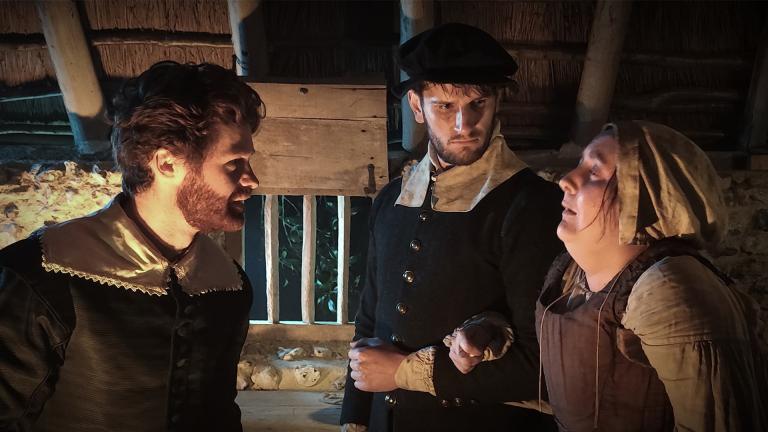
Read more about British History

Thousands of innocent women were sentenced to death as the ‘witch craze’ swept across Europe in the 16th and 17th centuries. The southeast England county of Essex alone was responsible for many of the most notorious witch trials in history.
Several of these get dedicated attention in the Sky HISTORY series Witches of Essex. Presenters Rylan Clark and Professor Alice Roberts uncover the very human stories behind the witch hunts.
They also expose the big villains — like ‘Witchfinder General’ Matthew Hopkins, whose crusade against alleged witches saw hundreds perish. It all started in the modest town of Manningtree.
Witches of Essex starts Tuesday 14 October 9pm on Sky HISTORY and HISTORY Play.
Little is known about Hopkins’ early life. He was born around 1620 to John Hopkins, a Puritan clergyman, in Suffolk. So, Matthew would have been a young man when he moved to Manningtree in the early 1640s. It is thought to be in Manningtree that he first met John Stearne shortly afterwards.
The two men were highly influenced by German Catholic clergyman Heinrich Kramer’s 1486 treatise the Malleus Maleficarum. This text not only argued for the existence of witchcraft but also put forward ideas for how this scourge could be tackled. The title literally translates into English as the ‘Hammer of Witches’.
As it turned out, Hopkins and Stearne didn’t have to look far for their first victim. It was all kicking off in Manningtree when, in 1645, disabled woman Elizabeth Clarke stood accused of cursing a tailor’s wife.
Elizabeth was soon assailed by a lynch mob, who took her to prominent Essex politician Sir Harbottle Grimston. In a tragic twist of fate for Elizabeth, Grimston owned the very land on which she lived, and couldn’t shake his own suspicions about her. Inevitably, then, ‘Bess’ (as she was also known) was put on trial.
In attempts to gather ‘evidence’ of Elizabeth’s guilt, ‘watchers’ monitored her. However, days passed without the accused slipping into any kind of seemingly incriminating behaviour.
Elizabeth was apparently on the brink of joining the already long list of alleged witches to have been acquitted during the English witching era. Unfortunately for Bess, though, Hopkins and Stearne soon took over the investigation — and their own methods were much more thorough.
Torturing a suspected witch was technically illegal in 1640s England. Still, most of us likely wouldn’t entirely agree with our 17th-century forbears on exactly which practices constituted torture. So, the legitimacy of sleep deprivation (the technique used on Elizabeth) was something of a legal grey area at the time.
Given that Clarke was denied sleep for days and nights on end, we probably shouldn’t be surprised that she apparently became disoriented enough to ‘confess’. Hopkins later told the court that he caught Clarke summoning familiars (demonic companions in animal form) — including a cat, greyhound and rabbit.
Bess not only identified herself as a witch but also implicated others living nearby. As a result of Elizabeth’s testimony, the total number of alleged witches eventually reached 36. Of these, four died in jail, while 19 were hanged.
Among the accused were Anne and Rebecca West, but only the former was executed. Rebecca had ‘outed’ her own mother, Anne, as a witch, and was ultimately judged to be a victim (rather than practiser) of sorcery.
Contemporaries initially thought that, with the so-called success of the Manningtree trials, the Witchfinder General had proved the viability of his rigorous methods. It did help Hopkins to make his name. Other communities beyond Manningtree reached out to Hopkins to request his services.
In his attempts to extract confessions, Hopkins resorted to various underhand tactics. These included throwing suspects into water (those who floated were deemed to be witches) and searching for the incriminating Devil’s Mark. This could be something as innocuous as a blemish or birthmark.
Hopkins is thought to have brought about potentially as many as 300 convictions over a fourteen-month period. By 1647, however, Hopkins and Stearne had been essentially ‘cancelled’ (to use modern parlance).
Belief in dark magic was widespread, but so were fears that innocent people were being wrongly convicted as witches. In the face of fierce criticism, Hopkins retired to Manningtree before dying later in 1647.
Keen to hear more about the witching era? By subscribing to the Sky HISTORY Newsletter, you can keep yourself updated about upcoming shows.